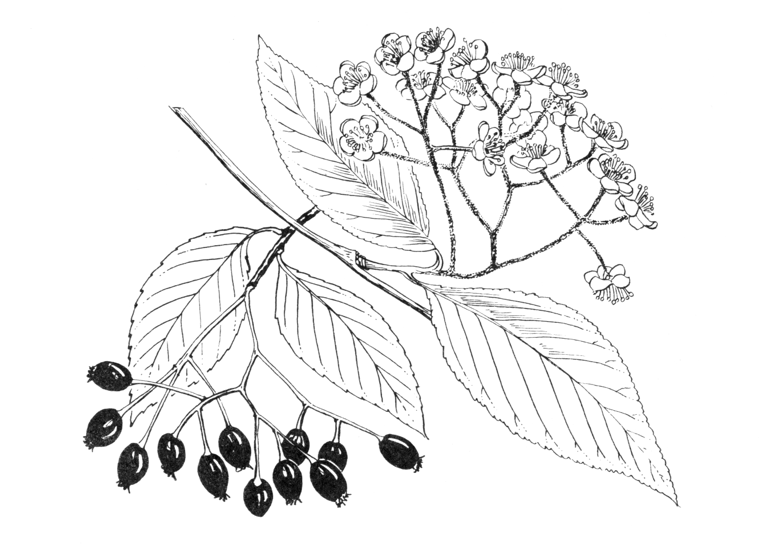A tree up to 30 ft high, with slender, often semi-pendulous branches; young shoots at first covered with whitish felt, becoming glabrous by autumn; winter buds pointed, slender, glabrous. Leaves lanceolate or narrowly ovate, tapering to both ends, 2 to 31⁄2 in. long, 3⁄4 to 11⁄4 in. wide, long-pointed, dark green and glabrous above, covered beneath with a close, beautifully silvery white felt; nerves parallel in eight to ten pairs; stalk about 1⁄2 in. long. Corymbs 3 to 4 in. across, sometimes rather elongated, carrying numerous rather densely arranged flowers 1⁄3 to 1⁄2 in. in diameter and white; calyx and flower-stalk woolly. Fruits oval or obovate, 1⁄2 in. across, ripening in late autumn or early winter, becoming red at least on the exposed side, devoid of calyx-teeth and with a small pit at the apex.
Native of Central and S.W. China; introduced by Wilson for Messrs Veitch about 1901. It varies somewhat in the more or less pendent character of its branches, and in one form, named f. pendula by Rehder, the habit is beautifully elegant, the branches arching outwards and drooping at the ends, and the leaves vividly white beneath.
In Dr Fox’s manuscript notes there are interesting remarks about this species, here quoted in full:
The seasonal displays of S. folgneri can be among the finest exhibited by a wild Sorbus species introduced into this country, but under conditions of cultivation they are provokingly variable. The foliage, though quite distinct in character, may alter in tinge from year to year. The tree is therefore better suited to be a companion to other Sorbus, rather than to be the only representative of its kind in the gardens of southern England, where it is perfectly hardy.
Its unusually soft leaves droop in loose clusters, a habit which distinguishes it from those of the Whitebeam for which they might be mistaken, being simple in form, and sometimes beautifully white beneath. On windy days a tree of S. folgneri can usually be detected by the characteristic shimmering of its half-silvery leaves. In the rate but unforgettable seasons when they turn golden pink on top in autumn, the foliage becomes brilliantly incandescent, and with its two tones of colour, is unmistakable.
cv. ‘Lemon Drop’. – fruits yellow. semi-pendulous habit. raised by messrs hillier.
There is a sorbus in cultivation which in general appearance strongly resembles S. folgneri, but differs in three respects: the leaves have only a thin veil of hairs beneath, the teeth ending the main lateral ribs are much longer than the others and on a few leaves could almost count as small lobes, and the calyx is persistent in fruit. A tree at Borde Hill of this character was identified by Bruce Jackson as S. zahlbruckneri Schneid. It is strange that a tree so like S. folgneri should have fruits with a persistent calyx, which remove it from section Micromeles into section Aria, but that is equally true of S. zahlbruckneri itself, for Schneider, in describing it from a specimen collected by Henry in Szechwan, wrote that he would have taken it to be a Micromeles but for this character. It may be that its proper place is indeed in section Micromeles, as an anomalous species. The French botanist Cardot noted that on some wild specimens of S. zahlbruckneri the calyx was in fact deciduous, and equally that it was sometimes persistent in S. folgneri.
There is another example of S. zahlbruckneri in the Winkworth Arboretum, with smaller leaves than those of the Borde Hill tree – a difference probably to be accounted for by the drier soil in which it grows.
The sorbus mentioned above should not be confused with the Chinese form of S. alnifolia (q.v.) originally distributed as S. zahlbruckneri. This was raised from Wilson’s seed-number 628, which was wrongly mentioned under S. zahlbruckneri in Plantae Wilsonianae.


